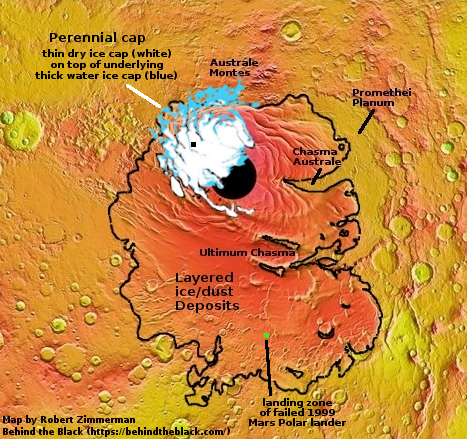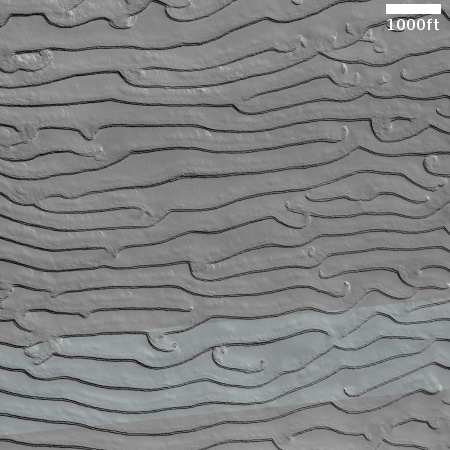The strange carbon dioxide ice cap of Mars’ south pole
Cool image time! The picture to the right, cropped to post here, was taken on July 1, 2024 by the high resolution camera on Mars Reconnaissance Orbiter (MRO). The image is labeled simply as a “terrain sample,” which usually means it was taken not as part of any specific research project but to fill a gap in the picture-taking schedule in order to maintain the camera’s proper temperate. When the camera team needs to do this, they try to picture interesting features availabe at that time slot. Sometimes the image is boring. Sometimes it is surprisingly interesting.
In this case the picture is the latter, and certainly quite alien. The curly parallel dark lines appear to be grooves, and seem to have ripple dunes within them, as if the only dust here got trapped in those low spots. It is also possible that the dunes are frozen and ancient, and are only being revealed as the top layer in each groove goes away.
What could possibly explain what we are looking at? The overview map below gives only a clue.

On the overview map to the right, the black dot in the middle of the ice cap of dry ice that lies on top of Mars south pole cap of water ice marks this location.
We are looking at a very large sheet of permanent dry ice, something we on Earth never see in a natural form. On Earth the temperatures are generally too warm for carbon dioxide to remain in its solid form, and so it quickly sublimates into gas if left out unprotected.
On Mars however the temperature and thin atmosphere is cold enough for dry ice to survive on the surface. For example, each winter the CO2 in the atmosphere falls as snow and forms a thin mantle of dry ice over both poles, from 60 degrees latitude and higher, only to sublimate back into the atmosphere with the coming of spring.
At the south pole however there is also a permanent ice cap of dry ice, as shown in white on the map to the right. Why the south pole has this permanent dry ice but the north pole does not is likely related to the different elevations and conditions between the poles, though the exact details are not yet understood.
Why this dry ice however forms these strange parallel lines is even less understood. Data from MRO images over many years suggest that dry ice cap is sublimating away, but generally that process looks very different than we see here.
As I have said many times, Mars is strange, Mars is wonderful, but above all, Mars is alien.
On Christmas Eve 1968 three Americans became the first humans to visit another world. What they did to celebrate was unexpected and profound, and will be remembered throughout all human history. Genesis: the Story of Apollo 8, Robert Zimmerman's classic history of humanity's first journey to another world, tells that story, and it is now available as both an ebook and an audiobook, both with a foreword by Valerie Anders and a new introduction by Robert Zimmerman.
The print edition can be purchased at Amazon or from any other book seller. If you want an autographed copy the price is $60 for the hardback and $45 for the paperback, plus $8 shipping for each. Go here for purchasing details. The ebook is available everywhere for $5.99 (before discount) at amazon, or direct from my ebook publisher, ebookit. If you buy it from ebookit you don't support the big tech companies and the author gets a bigger cut much sooner.
The audiobook is also available at all these vendors, and is also free with a 30-day trial membership to Audible.
"Not simply about one mission, [Genesis] is also the history of America's quest for the moon... Zimmerman has done a masterful job of tying disparate events together into a solid account of one of America's greatest human triumphs."--San Antonio Express-News
Cool image time! The picture to the right, cropped to post here, was taken on July 1, 2024 by the high resolution camera on Mars Reconnaissance Orbiter (MRO). The image is labeled simply as a “terrain sample,” which usually means it was taken not as part of any specific research project but to fill a gap in the picture-taking schedule in order to maintain the camera’s proper temperate. When the camera team needs to do this, they try to picture interesting features availabe at that time slot. Sometimes the image is boring. Sometimes it is surprisingly interesting.
In this case the picture is the latter, and certainly quite alien. The curly parallel dark lines appear to be grooves, and seem to have ripple dunes within them, as if the only dust here got trapped in those low spots. It is also possible that the dunes are frozen and ancient, and are only being revealed as the top layer in each groove goes away.
What could possibly explain what we are looking at? The overview map below gives only a clue.

On the overview map to the right, the black dot in the middle of the ice cap of dry ice that lies on top of Mars south pole cap of water ice marks this location.
We are looking at a very large sheet of permanent dry ice, something we on Earth never see in a natural form. On Earth the temperatures are generally too warm for carbon dioxide to remain in its solid form, and so it quickly sublimates into gas if left out unprotected.
On Mars however the temperature and thin atmosphere is cold enough for dry ice to survive on the surface. For example, each winter the CO2 in the atmosphere falls as snow and forms a thin mantle of dry ice over both poles, from 60 degrees latitude and higher, only to sublimate back into the atmosphere with the coming of spring.
At the south pole however there is also a permanent ice cap of dry ice, as shown in white on the map to the right. Why the south pole has this permanent dry ice but the north pole does not is likely related to the different elevations and conditions between the poles, though the exact details are not yet understood.
Why this dry ice however forms these strange parallel lines is even less understood. Data from MRO images over many years suggest that dry ice cap is sublimating away, but generally that process looks very different than we see here.
As I have said many times, Mars is strange, Mars is wonderful, but above all, Mars is alien.
On Christmas Eve 1968 three Americans became the first humans to visit another world. What they did to celebrate was unexpected and profound, and will be remembered throughout all human history. Genesis: the Story of Apollo 8, Robert Zimmerman's classic history of humanity's first journey to another world, tells that story, and it is now available as both an ebook and an audiobook, both with a foreword by Valerie Anders and a new introduction by Robert Zimmerman.
The print edition can be purchased at Amazon or from any other book seller. If you want an autographed copy the price is $60 for the hardback and $45 for the paperback, plus $8 shipping for each. Go here for purchasing details. The ebook is available everywhere for $5.99 (before discount) at amazon, or direct from my ebook publisher, ebookit. If you buy it from ebookit you don't support the big tech companies and the author gets a bigger cut much sooner.
The audiobook is also available at all these vendors, and is also free with a 30-day trial membership to Audible.
"Not simply about one mission, [Genesis] is also the history of America's quest for the moon... Zimmerman has done a masterful job of tying disparate events together into a solid account of one of America's greatest human triumphs."--San Antonio Express-News



Cool looking Mars maze. I couldn’t find any easy way through.
All I could think of for how it formed was a half billion years or so of freezer-burn/sublimation. BTW – CO2 ice crystals are about 100x smaller than H2O ice crystals/flakes, and very densely packed (cuboctahedral).
I discovered a package of freezer-burn sausages starting look similar after a couple of months at the bottom of my freezer.